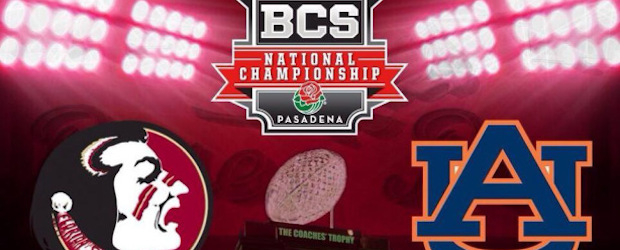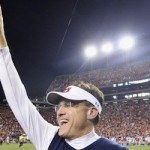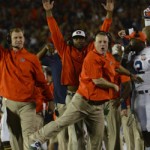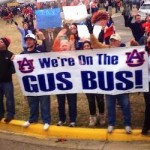In 1997, the Fort Smith Southside Rebels completed what prep football historian Leland Barclay has called “the most miraculous turn-around” in Arkansas history. In 1996, the Rebels suffered a 1-9 season. In response, head coach Barry Lunney Sr. ditched the Wing-T offense and adopted a wide open passing attack. His quarterback son, Daniel Lunney, passed for a then-record 3,555 yards and 37 touchdowns in 1997 to lead Southside to a 12-2 record and state title.
Watching Lunney pull this magic off was Gus Malzahn, the young coach of Shiloh Christian Academy. Malzahn, who had grown up in Forth Smith, had looked up to Lunney and admired his coaching style for years. Like Lunney, he was an acolyte of the Wing T system. But he had ditched it one year earlier, in 1996, to adopt a fast-paced, spread passing attack which helped fuel the Saints to four straight state title game appearances. Malzahn and his teams became so adept at the new offense that he literally wrote the book on it: “The Hurry-Up, No-Huddle: An Offensive Philosophy.”
That publication isn’t Malzahn’s signature work, though. Malzahn’s most monumental achievement is 13 games in the making and only needs a finishing stroke tonight. If his Auburn Tigers win against Florida State in the BCS National Championship Game, they will achieve the closest approximation to the 1996-97 Southside turnaround that major college football has ever seen. Indeed, nothing quite like this would have ever happened on a national scale.
Malzahn and other Arkansan coaches on his staff have already crafted one of the game’s most innovative and explosive run-based offenses by marrying a dizzying array of deceptive tactics to decades-old Wing T principles. They are now on the brink of engineering the greatest one-season turnaround in the history of American team sports.
No. I don’t type this while taking advantage of Colorado’s new marijuana laws.
It’s just that there’s no other team out there, in college or pro sports, which has so unexpectedly improved in terms of sheer wins and postseason results. Consider Auburn has already tied for the best one-season improvement in major college football history by notching a 12-1 record a year after going 3-9. Hawaii also improved by 9 games in 1998-99, but its resurgence peaked with a 9-4 record and berth in the Oahu Bowl, not the national title game.
Likewise, Towson pulled off the greatest one-year turnaround in Division I college basketball last season by improving to 18-3 from 1-31 the year before. Most administrators don’t relish one-win seasons. Mike Waddell, the Razorbacks’ senior associate athletic director, isn’t an ordinary administrator. In January 2012, as Towson’s athletic director, Waddell believed things were looking up despite what was then an 0-20ish record. “You get to write the prologue in what’s going to be the greatest turnaround story in college basketball,” he told Grantland.
Towson, though, didn’t get a chance to play beyond its regular season. The program was ineligible for the postseason because of NCAA Academic Progress Rate standards. Even had it gotten into the Big Dance, its chances of making the title game were infinitesimal.
A few college football teams have turned in undefeated, national championship seasons a year after hovering around .500. Take Arkansas, which under coach Frank Broyles and seniors like Fred Marshall and Ronnie Caveness, rebounded from a 5-5 season in 1963 to turn in a 11-0 campaign in 1964. Check Clemson, which finished 6-5 in 1980. One year later, under the leadership of future Arkansas coach Danny Ford, the Tigers finished 12-0 despite mounting allegations of recruiting violations.
When looking at modern era teams which have in one year gone from legit cellar dweller to the brink of a national title, only a couple are in Auburn’s stratosphere. One is Minnesota, which integrated its football team in the late 1950s, bringing on board Sandy Stephens, who would become the first African American to win All-American honors as a quarterback. In 1959, Minnesota suffered its second straight horrid season, going 2-7 and finishing last in the Big Ten. Head coach Murray Warmath’s home was vandalized and he was hung in effigy. But the next season Minnesota roared to an 8-1 record and was voted national champions by the Associated Press and United Press International. Those votes, however, came before bowl season. Minnesota lost the 1961 Rose Bowl 17-7 to Washington.
A few years later, Notre Dame was on track for history’s greatest U-turn. Notre Dame had suffered a 2-7 record in 1963 under interim coach Hugh Devore, but like at Auburn this year a new head coach fueled a rapid return to glory. In 1964, Ara Parseghian coached the Fighting Irish to wins in their first nine games and No. 1 ranking before their season final against the University of Southern California. A flat second half doomed Parseghian’s bunch, though, and Notre Dame lost 20-17 to finish 9-1.
In pro sports, star players are more responsible than coaches for the most impressive bounce backs. In the NFL, the 1928 Giants finished 4-7-2. But over the offseason, New York owner Tim Mara picked up passing/running/kicking star Benny Friedman by buying the entire squad off the recently-folded Detroit Wolverines franchise, which had finished in third place in 1928. So the roster of the 1929 Giants was essentially comprised of the best of two teams. New York finished 13-1-1 but lost its only showdown with eventual champion Green Bay.
The Boston Red Sox stumbled through a 71-83 mark in 1945 but a year later some of its most talented players, including Ted Williams, returned from military duty. Williams put in an MVP season in 1946, leading Boston to a 104-50 record and a World Series berth. But Boston lost 4-3 to St. Louis. Sixty seven years later, in the fall of 2013, the two franchises again squared off in the World Series with Boston again coming off a subpar season. The Red Sox had lost 93 games in 2012 before picking up veterans with something to prove in Shane Victorino, Jonny Gomes, Stephen Drew and former Arkansas Traveler Mike Napoli. They helped Boston beat St. Louis this time around to wrap an improbable 97-win season.
In pro basketball, the gold standard belongs to yet another Boston team, as well as a franchise in the now-defunct American Basketball Association. The Oakland Oaks, which existed 1967 through 1969, likely had the most Jekyll-and-Hyde existence in sports history. The franchise badly flopped in its first season, 1967-68, only winning 28% of its games while its recent superstar signee, Rick Barry, sat on the bench because of a contract dispute with his former NBA team. The next season was the franchise’s last in Oakland . The Oaks brought in a proven NBA coach, Alex Hannum, and future Hall of Famers like Larry Brown and Doug Moe. Barry scored more than 30 points per game, and when he went down with injury rookie Warren Armstrong picked up the scoring slack. Oakland took the 1969 ABA championship after winning nearly 80 percent of its games.
The NBA’s only turnaround of this magnitude happened nearly 40 years later. In 2006-07, the Celtics were the NBA’s second-worst team, limping to a 24-58 finish. But the following summer Boston pulled off trades for superstars Ray Allen and Kevin Garnett to completely reboot the team’s personality. These future Hall of Famers perfectly meshed with established All-Star Paul Pierce and emerging star Rajon Rondo to help Boston win 42 more games in 2007-08 and defeat the Lakers for the title.
In the modern NFL, there have been a few great rags-to-riches stories. The Boomer Esiason-led 1988 Cincinnati Bengals and 2001 Tom Brady-led New England Patriots immediately jump to mind. But none of those narratives surpass the 1999 St. Louis Rams in sheer unlikelihood. In 1998, the Rams were their usual awful self, losing 12 of 16 games while finishing near the bottom of the league in offense and defense.
Not much more was expected of them the following season despite the drafting of wide receiver Torry Holt and the signing of All-Pro tailback Marshall Faulk, then widely considered a malcontent. Even less was expected when starting quarterback Trent Green was injured in preseason, pushing his backup, a former Arena Football Leaguer named Kurt Warner, into the spotlight.
The rest is history: Warner, Holt and Faulk clicked, defensive players like Kevin Carter had career years and St. Louis set multiple team and league records en route to a 13-3 finish and a Super Bowl win over Tennessee.
Through it all, the Rams’ story seemed all the more amazing because its star – Kurt Warner – was cast as a underdog who had scrapped his way to the top. Gus Malzahn now stands in a similar position. A decade ago, the then 38-year-old was still coaching high school football in Arkansas. Just one and half years ago, he had yet to be a head coach in a college football game.
Now he has the chance to put the finishing touches on a turnaround more impressive than even the Rams’ 1999 season. Entering that fall, St. Louis faced odds as low as 300-1 to win the Super Bowl, according to kostats.com, a sports statistical site. Auburn, by contrast, faced 1,000-1 odds to win the title after last season.
Long odds to be sure, but not as daunting as the ones Malzahn once faced to even get to this point.
He was living in a trailer in the Arkansas Delta 23 years ago after he got his first coaching and teaching job. “I didn’t have a clue what I was doing,” he told Sports Illustrated. He proved to be an eager study, though, and after a single season was promoted from Hughes’ defensive coordinator to its head coach. Looking for quick instruction, he found a well-known book in coaching circles called the “The Delaware Wing-T: An Order of Football.” Malzahn memorized it all. Naturally inventive, hehad at last found himself a template to tinker with. At first, the wins came slowly.
That changed in a hurry.
***
Gus Malzahn’s Twitter account once destroyed Evin Demirel’s Twitter account in what was supposed to be a relaxed game of pickup softball. In Evin’s most recent blog entry, he compare Trey Flowers to Neo from the Matrix.












